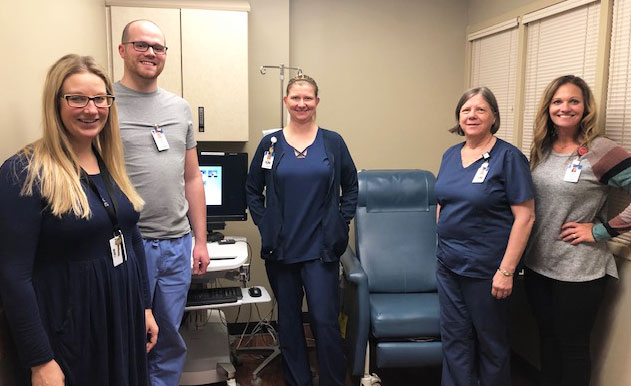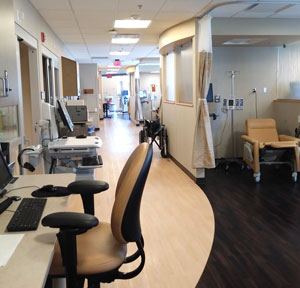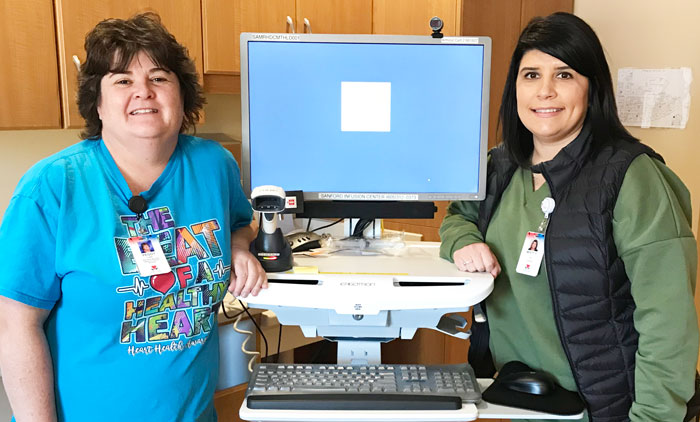The Rural Virtual Infusion Program
- Need: Allow rural cancer patients in a region inclusive of 26 counties in Iowa, Minnesota, and South Dakota to have access to tertiary-level chemotherapy regimens administered in rural infusion centers.
- Intervention: With telehealth-based oversight from a tertiary care oncology team, 3 rural infusion teams were trained to coordinate cancer treatment plans and administer complex chemotherapy regimens.
- Results: The original grant-supported effort — with its results of saving130 patients 65,000 trip miles and 1,800 travel hours – proved sustainable.
Evidence-level
Promising (About evidence-level criteria)Description
 For hematologists, oncologists, and
oncology-trained advanced practice professionals in
tertiary care centers, the delivery of complex modern
cancer chemotherapy regimens is routine. Prior to
patients receiving infusion treatments, these
practitioners provide a thorough review that includes an
evaluation of recent laboratory and radiology results and
an assessment of a patient's current physical condition.
For patients in clinical cancer treatment trials,
stringent guidelines often specify direct oversight by
these specialty providers. In addition, specialty
supervision is often needed when a patient's cancer
requires a treatment regimen using medications with
significant side-effect potential. These specialty
requirements and linked expertise can be seen as barriers
to rural patients receiving advanced cancer treatments in
their home healthcare facilities.
For hematologists, oncologists, and
oncology-trained advanced practice professionals in
tertiary care centers, the delivery of complex modern
cancer chemotherapy regimens is routine. Prior to
patients receiving infusion treatments, these
practitioners provide a thorough review that includes an
evaluation of recent laboratory and radiology results and
an assessment of a patient's current physical condition.
For patients in clinical cancer treatment trials,
stringent guidelines often specify direct oversight by
these specialty providers. In addition, specialty
supervision is often needed when a patient's cancer
requires a treatment regimen using medications with
significant side-effect potential. These specialty
requirements and linked expertise can be seen as barriers
to rural patients receiving advanced cancer treatments in
their home healthcare facilities.
To overcome these barriers to modern cancer care, in 2015-2018, Sanford Vermillion Medical Center, Vermillion, South Dakota, led a successful grant-funded pilot — referred to as the Rural Virtual Infusion Project — by using telehealth tools and sustainable infrastructure and workflows.
Along with the original Vermillion team as the grant awardee, 2 additional rural partners were involved with the project: Douglas County Memorial Hospital, Armour, South Dakota, with outreach into Iowa; and Sanford Worthington Medical Center, Worthington, Minnesota, with a population of nearly 35% non-White, non-English speaking residents. The rural teams included infusion nurses and pharmacists. Key to the project's original workflow were the urban-based Sioux Falls, South Dakota hematologists and oncologists with Sanford Hematology and Oncology. Also specific to the success were the Sioux Falls-based oncology-certified nurse practitioners, oncology-certified registered nurses, and pharmacists.
Solving access to oncology specialty oversight for rural areas was the prime objective of the project. The final solution was based on the existing infusion center model in the tertiary care center where a Certified Nurse Practitioner (CNP) was physically present to oversee the 24-chair/4-bed center, with oncologist oversight. In that setting, the CNP reviewed laboratories and treatment plans for the day's scheduled patients and was immediately available for any patient concerns, nursing concerns, medication side effect problems or infusion reactions. If needed, the CNP also had ready access to the on-site hematologists and oncologists. The original project's final care model used telehealth to virtually integrate the rural infusion sites workflow into the tertiary infusion center's workflow.
Specific to the telehealth rural infusion model was telehealth equipment and communication strategies that included a designated telephone, an electronic health record (EHR) that accommodated two-way communication and order placement. Videoconferencing was available when needed. Workflow also included the standard oncology 3-step verification process: provider treatment plan review and sign-off; nurse assessment of patient readiness, treatment plan and order review; all followed by the release of the chemotherapy order to the pharmacy where a pharmacist performs drug order verification and subsequently releases the chemotherapy agent to the infusion nurse.

Technology insight to the original project team was provided by Sanford's Sioux Falls-based health information technology specialists. During early planning, the project partners found literature looking at specifics of telehealth oncology office visits, but few published models mirrored their anticipated infusion treatments. This discovery became an opportunity to invite the tertiary center's research team to contribute to the project.
Also addressed during the original project was the need for multiple levels of required security and organizational approval to make special EHR software modifications to allow interoperability for virtual communication between the tertiary and rural teams. The tertiary team members were credentialed for telehealth privileges in the rural healthcare organizations. Rural infusion staff participated in rigorous clinical training sessions to gain needed certification for partnership with the tertiary team.
Research team members also presented available clinical trial results to allow the original team to have evidence-informed information to guide their project.
This project received support from the Federal Office of Rural Health Policy's (FORHP) 2015-2018 Rural Health Care Services Outreach Grant Program.
Services offered
For patients/families:

- Expanded local chemotherapy cancer treatment options, including engagement in clinical trials if eligible.
For rural infusion staff:
- The tertiary care staff provides timely communication with the needed specialty-specific expertise required for the rural partners to deliver advanced cancer treatment regimens to their patients in rural locations.
Results

The original 2015-2018 project's results — strategic for the model's sustainability, included the following:
- As a result of the tertiary center's oncology CNP
providing direct oversight for rural infusion center
patients, from a baseline of 6 patients, 127 patients
were transitioned to receive local care — translating
into over 1,000 infusion visits and saving
patients/families nearly 65,000 trip miles, 1,800 travel
hours, and an estimated $71,000.
- Additionally, local infusion care prevented treatment lapse that might have occurred due to weather-related travel barriers.
- Patients not only were able to receive tertiary-level oncology care in their local communities, but they could participate in clinical trials if eligible, an opportunity that often affords improved quality of life during and after treatment and potentially contributes to expanding cancer knowledge and future cancer treatment, according to the National Cancer Institute.
- Rural site lessons learned during this project led
to:
- Increased EHR interoperability allowed for the needed timely communication between the tertiary and rural sites.
- Improved rural infusion site workflow efficiency.
- Consideration by the rural sites to engage in other partnerships to provide oversight for colorectal and pancreatic cancer patients receiving continuous 24/7 chemotherapy treatment through portable infusion pumps.
- Lessons learned by hematology/oncology specialists:
- Increased familiarity with care delivery using telehealth infrastructure led to an increased comfort with transitioning patient care to a rural infusion center.
- Increased cancer trial referrals for rural patients.
- Increased comfort with telehealth in general which likely drove the 170 percent change in specialists' telemedicine visits documented from year to year during the grant cycle. Specifically, in the 2nd grant cycle year, 38 to 102 visits and in the 3rd grant year, 102 to 277.
- Safety-oriented workflows proved effective when 4 medication variances did not reach patients.
- No sentinel events occurred during the grant cycle.
- No infusion-related hospitalizations.
- High satisfaction survey results for all groups: patients, physicians, CNPs, and infusion center staff.
The project team has presented at the following conferences:
Regional:
- 2017 Sanford Nursing Research and Evidence Based Conference poster presentation, Sioux Falls, South Dakota.
- 2018 South Dakota State University Telehealth Symposium, Sioux Falls, South Dakota.
- 2018 Sanford Performance Improvement Symposium: "Shaping the Future" poster presentation, Sioux Falls, South Dakota.
- 2018 Sanford Cancer Symposium, Sioux Falls, South Dakota.
National:
- Journal of the Advanced Practitioner in Oncology's (JADPRO) live poster presentation at the 2017 Advanced Practitioner Society for Hematology and Oncology (APSHO), Houston, Texas.
- 2018 National Oncology Conference Invited Speaker, sponsored by Association of Community Cancer Centers (ACCC), Phoenix, Arizona.
International:
- August 2019: 4th Nursing World Conference, London, England. Accepted abstract presentation.
The team was also nominated for the 2018 ACCC Innovator Award.
For more about this project:
Halbritter, S., Kaiser, J., Olson, R., Mcguire, J., Dufek, P., Cranston, J., et al.. 2019. Virtual Infusion Services: Bringing cancer therapies closer to rural patients. ACCC Immuno-Oncology Institute. September-October. 24-31.

Challenges
- Although CNP coverage was to continue for the initial rural sites requesting the service, physician-level services were anticipated to need a reimbursement model to continue, with consideration at that time given to a volume-based subscription fee.
- At each rural site, administration/management teams needed to be able to balance gains through virtual infusion services against the cost and requirements of the service.
- Low patient volume at one site.
Replication

Lessons learned from the original project that originally demonstrated continued relevance were as follows:
- Success for a project associated with high-risk medications requires an interdisciplinary core team to focus on universal adoption of the tertiary center's mandatory infusion policies and procedures in order to keep the tertiary center's program accreditation and certification.
- Universal adoption of standardized work flows.
- Need for an EHR with adequate interoperability to meet project needs.
- Quality telehealth equipment purchases need to be made with endorsement of both tertiary and rural sites.
- Development of a Community Awareness Campaign prior to implementation that includes direct mailings, radio spots, Facebook presence, and other social media and community outreach activities.
- Be prepared that word-of-mouth promotion of the program's success may prompt service requests from other rural community areas surrounding the tertiary care center.
Topics
Access
· Cancer
· Limited English proficient
· Outpatient care
· Pharmacy and prescription drugs
· Specialty care
· Telehealth
States served
Iowa, Minnesota, South Dakota
Date added
April 10, 2019
Suggested citation: Rural Health Information Hub, 2025 . The Rural Virtual Infusion Program [online]. Rural Health Information Hub. Available at: https://www.ruralhealthinfo.org/project-examples/1055 [Accessed 10 December 2025]
Please contact the models and innovations contact directly for the most complete and current information about this program. Summaries of models and innovations are provided by RHIhub for your convenience. The programs described are not endorsed by RHIhub or by the Federal Office of Rural Health Policy. Each rural community should consider whether a particular project or approach is a good match for their community’s needs and capacity. While it is sometimes possible to adapt program components to match your resources, keep in mind that changes to the program design may impact results.
